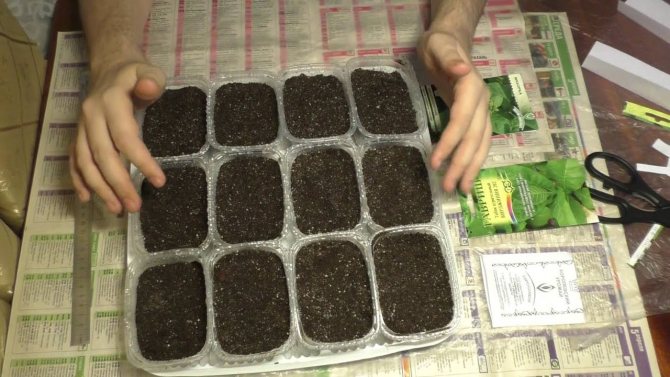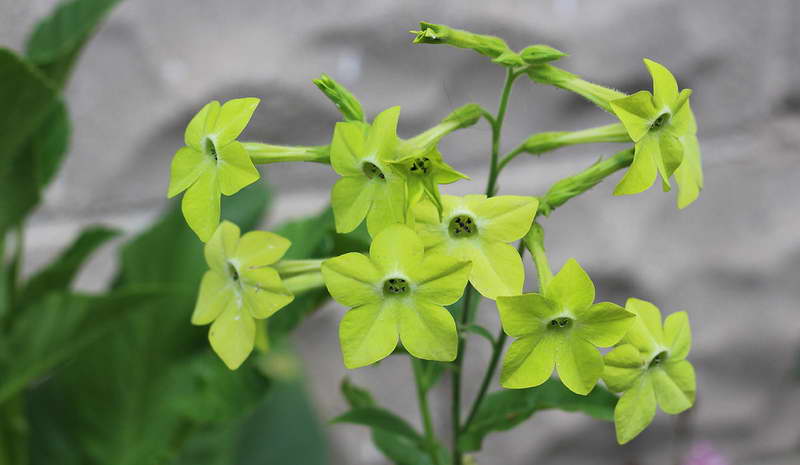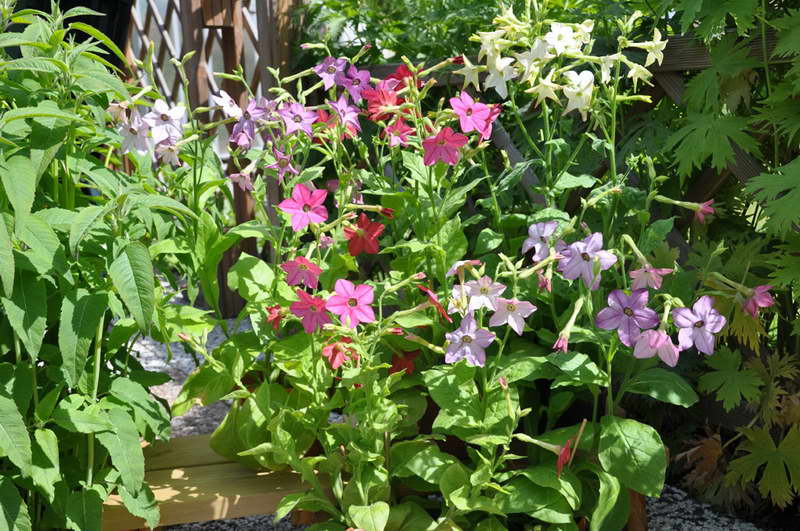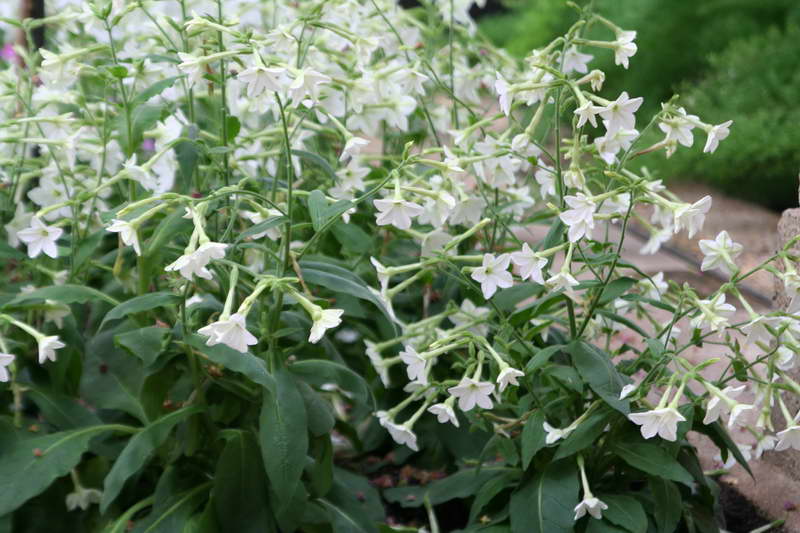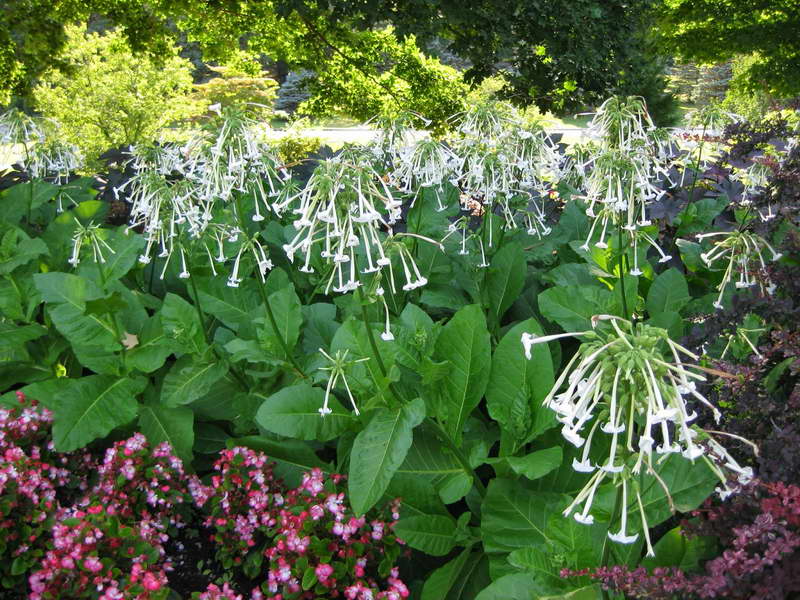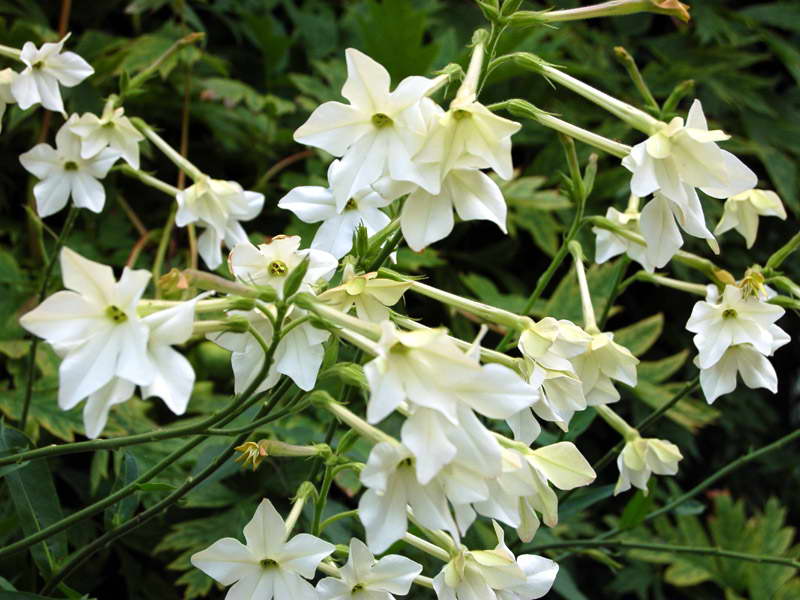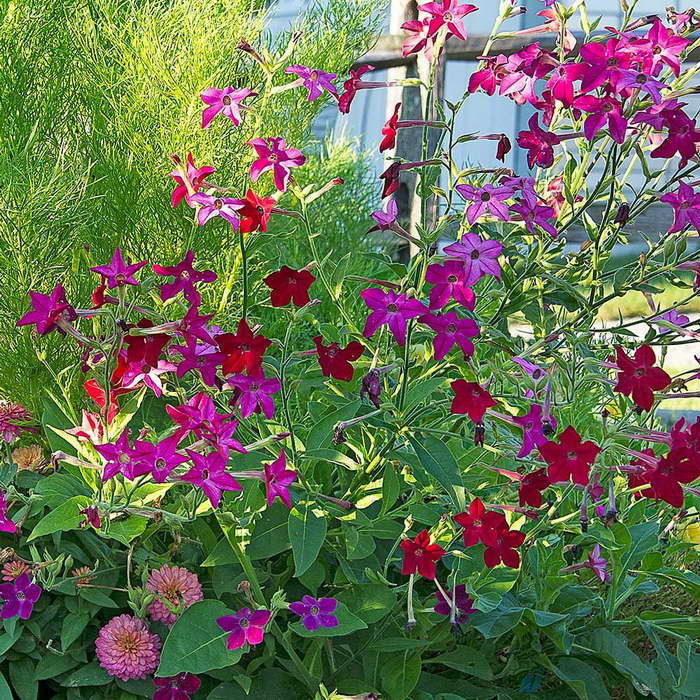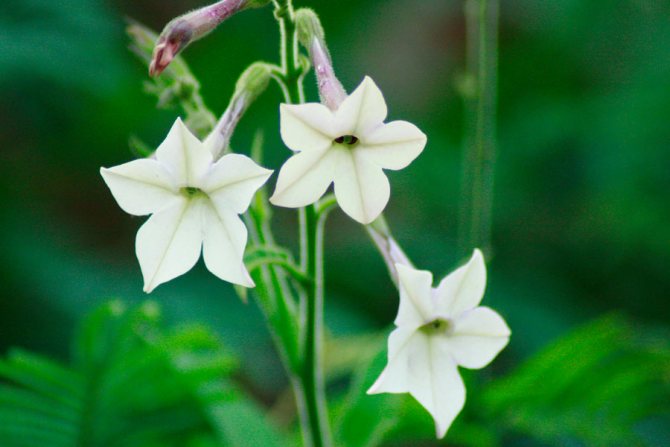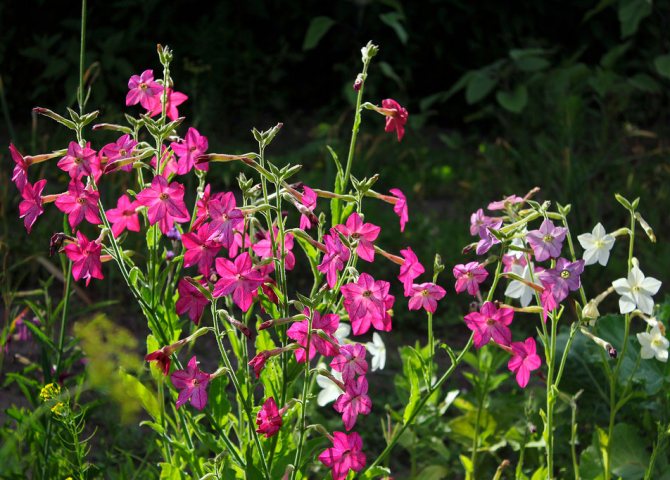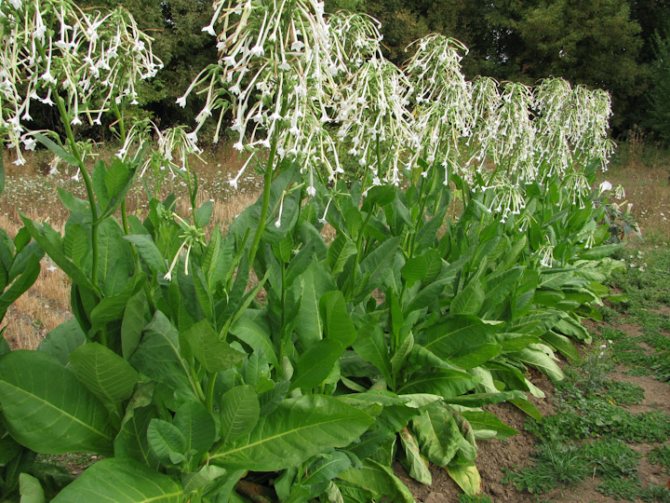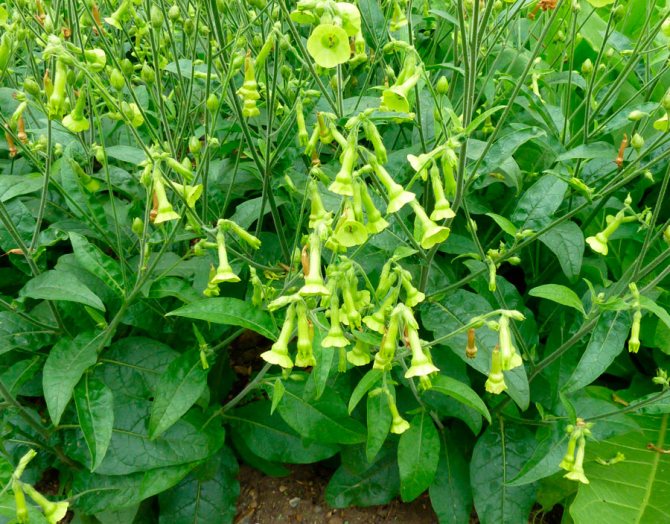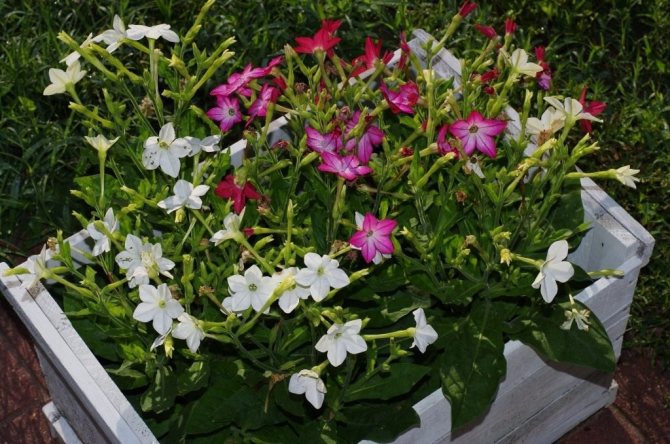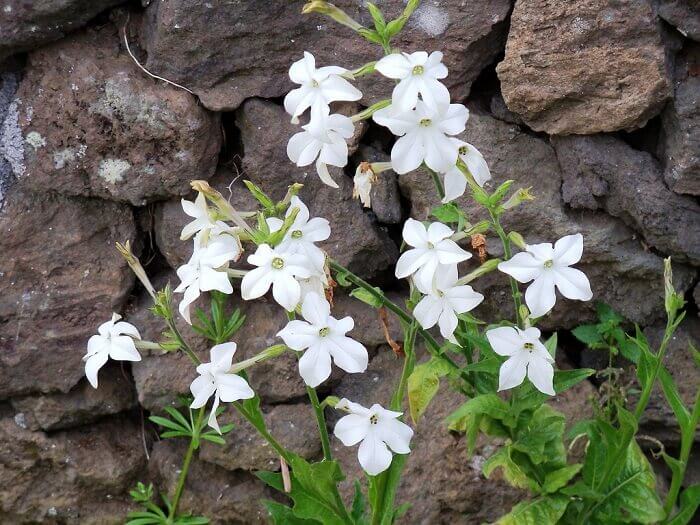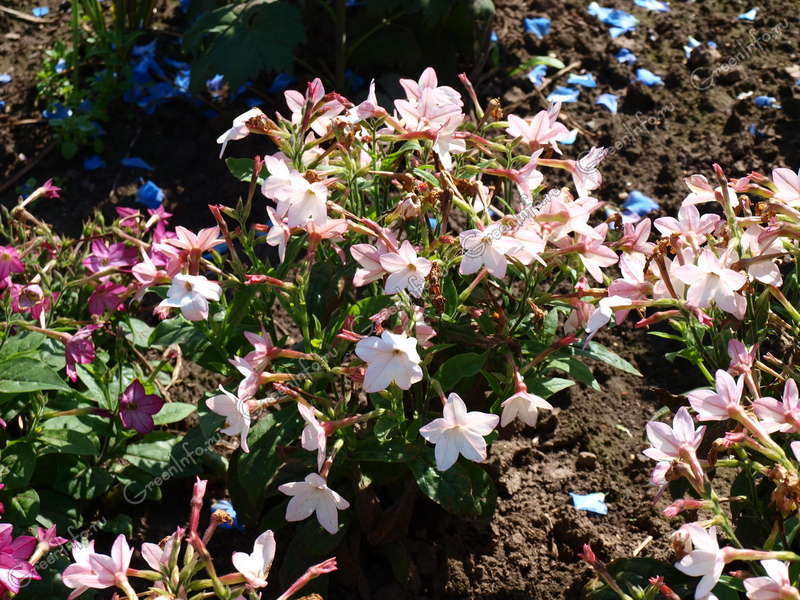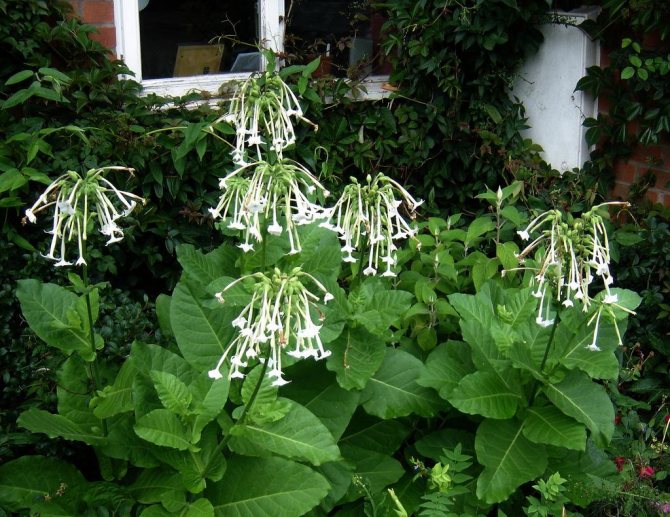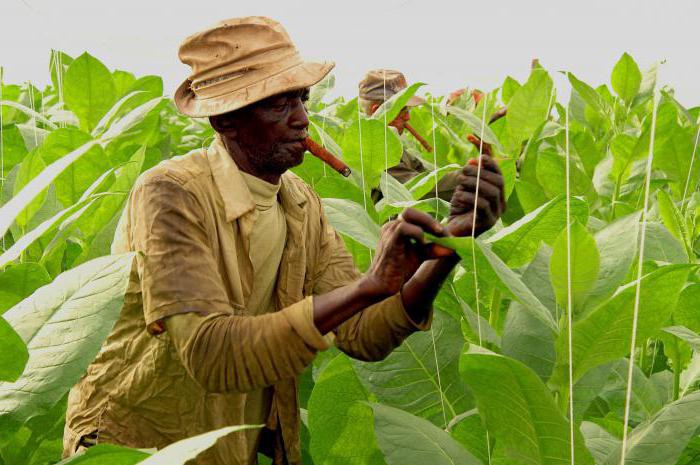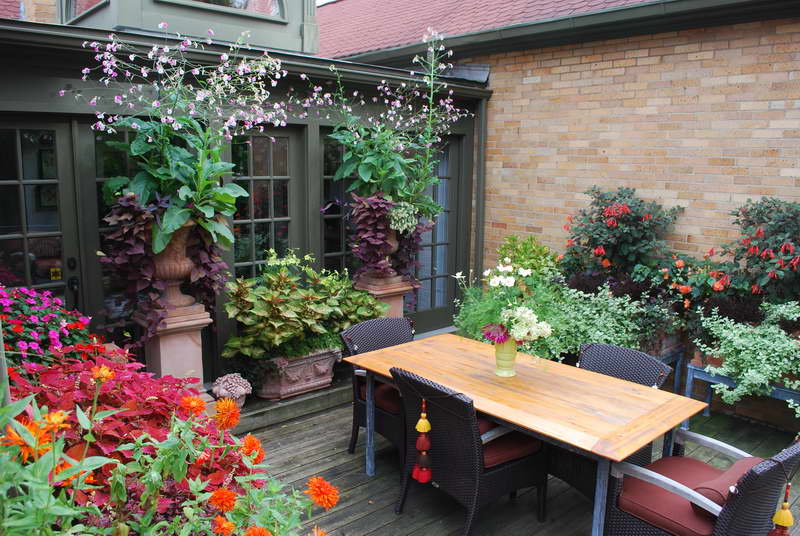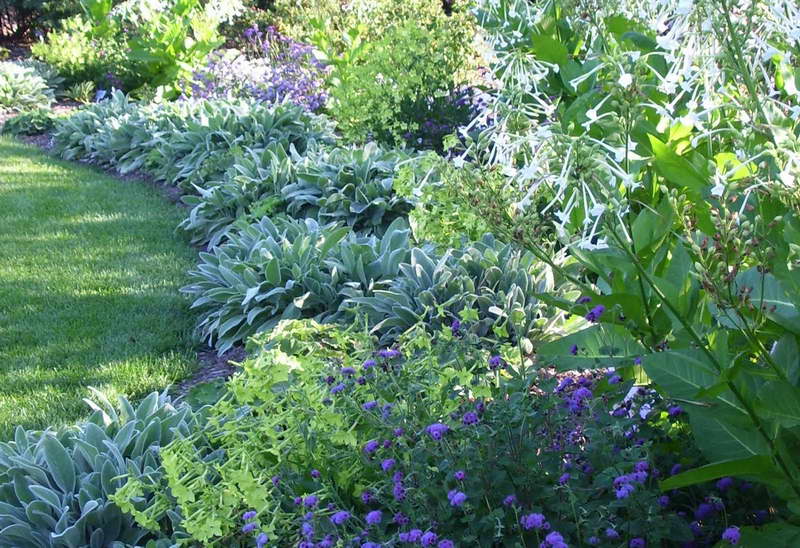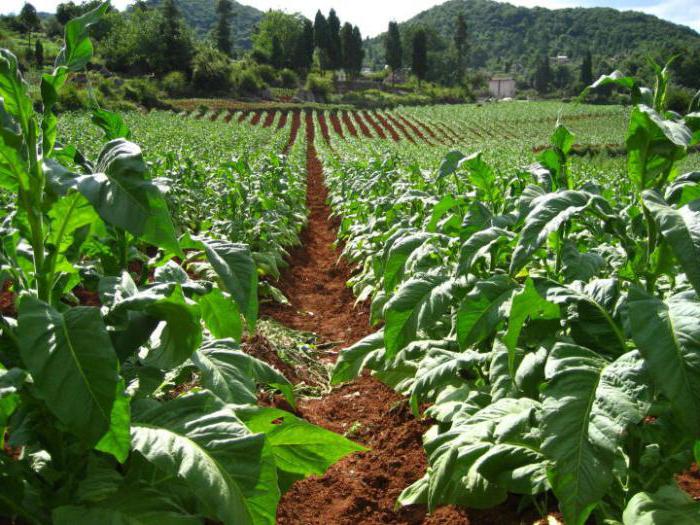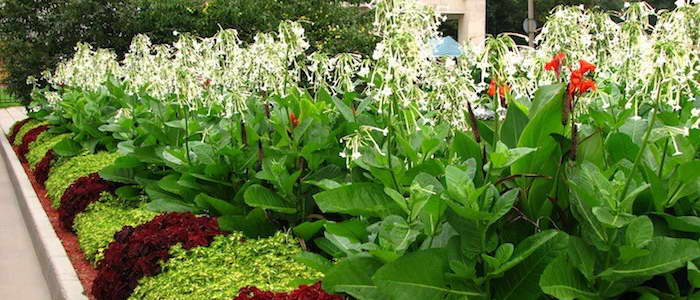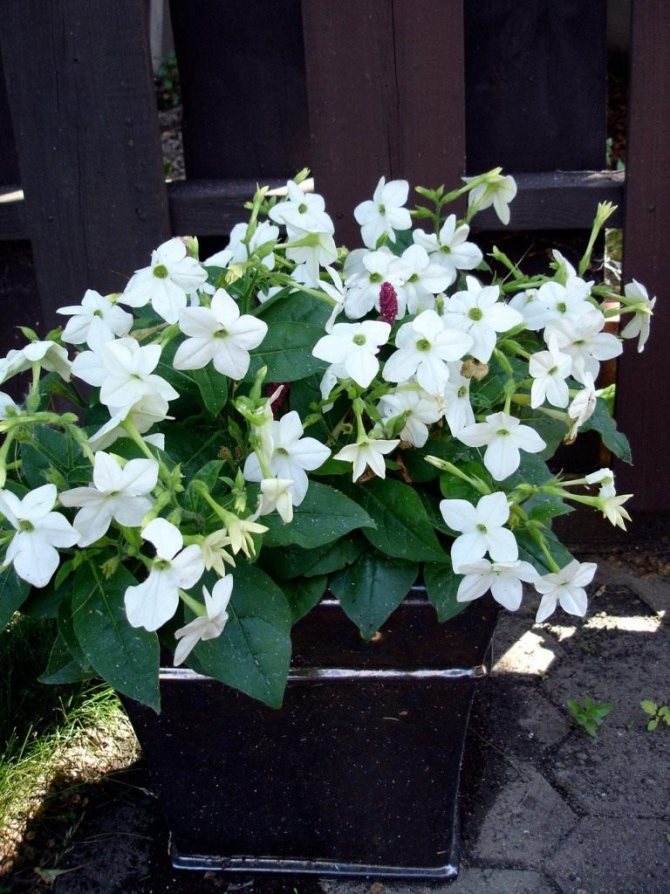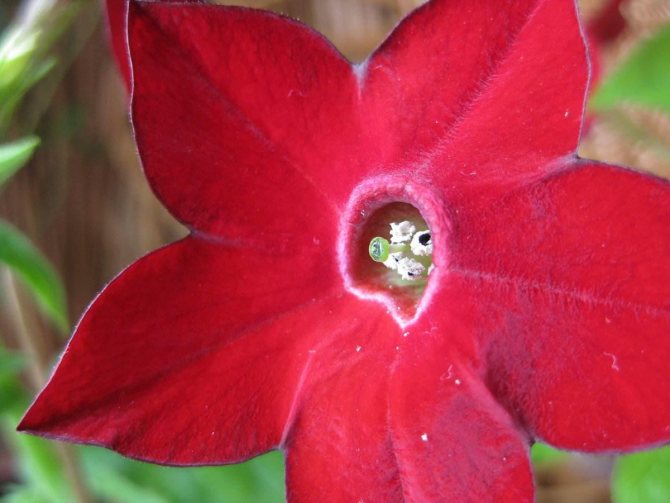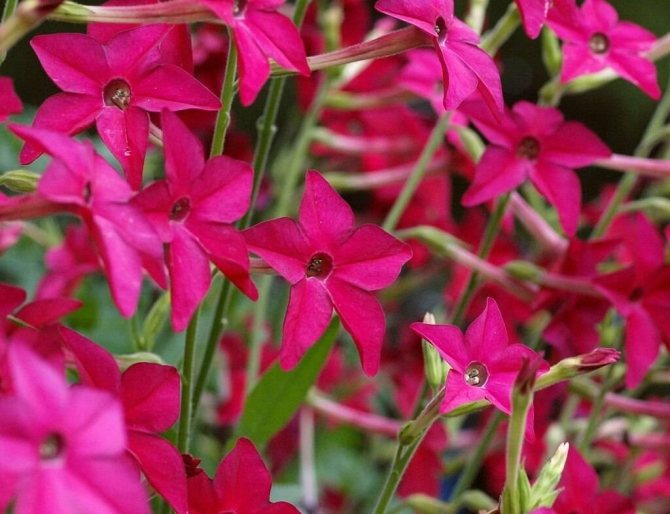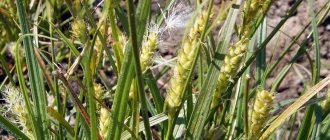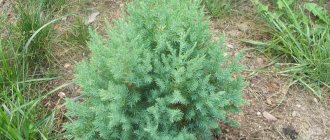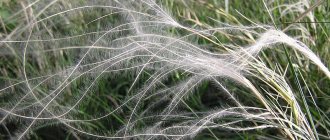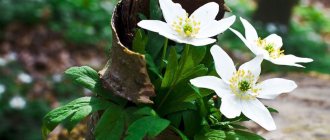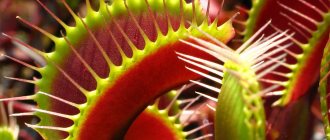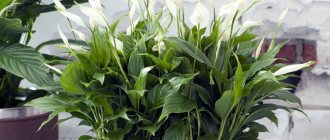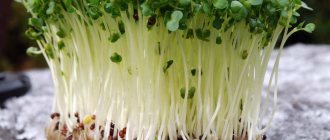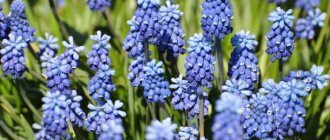For a long time, the flowering plant, fragrant tobacco, has been very popular with gardeners. And he deserved it because he has an original smell, and the color of his flowers is very diverse. The aroma of such a plant is able to attract bees to the garden area, and it also has a huge number of different varieties. This culture comes from South America. Thanks to Christopher Columbus, fragrant tobacco came to the territory of Europe. Under natural conditions, it is a perennial plant, but in the middle latitudes it is cultivated as an annual.
The origin of the word "tobacco"
This plant was named nicotiana after the French ambassador to Portugal, Jean Nico. And the word tabaco first appeared in the work of the author Juan de Valdes, who designated this term as a kind of cane stick for smoking. Such a pipe was called tobago in the speech of the primitive tribes of Haiti.
It is noteworthy that in Dahl's dictionary the meaning of the word "tobacco" is explained as "a filthy, prodigal, antichrist, satanic potion."
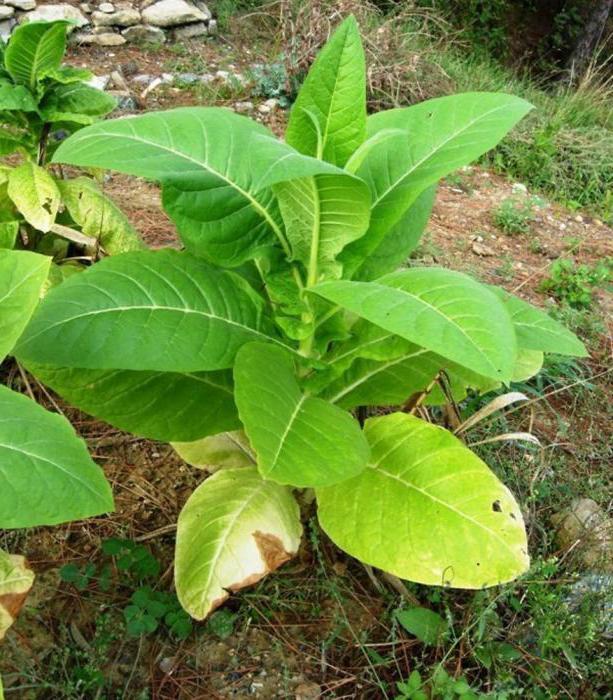
Origin
Initially, this annual grew in the countries of the South American continent - in Mexico, Peru and Bolivia. From there it gradually spread to other continents. Large tobacco plantations are found in North America, Asian countries, in particular in India and China. On the territory of the former Soviet Union, ordinary tobacco is grown in the countries of the Transcaucasus, on the territory of the Crimean Peninsula, in the Krasnodar Territory, in the Central Asian republics, as well as in Moldova.


Homeland of tobacco
Growing tobacco
What does tobacco look like? Photos of the plant are posted in the article. Tobacco has a yellowish-white, taproot and an erect, cylindrical, non-branched stem 1.2-2 m high. Tobacco leaves are light green, large, oblong-elliptical, with an average width of 30 cm and a length of 90 cm. covered with small glandular hairs that secrete a sticky liquid with an unpleasant odor. Tobacco flowers are large, funnel-shaped, five-pointed in shape. They are collected in groups at the top of the stem and can have a very different color: red, white, pink, purple. Flowers bloom at night. The seeds are found in brown, capsule-like fruits.
The most favorable soil for growing tobacco is black soil, but it is grown on a wide variety of soils and even in unsuitable climatic conditions. Today tobacco is grown all over the world. China and the United States rank first in its production, followed by India, Brazil, Russia and Turkey. In the Russian Federation, the main places for cultivation of tobacco are Krasnodar and Stavropol Territories.
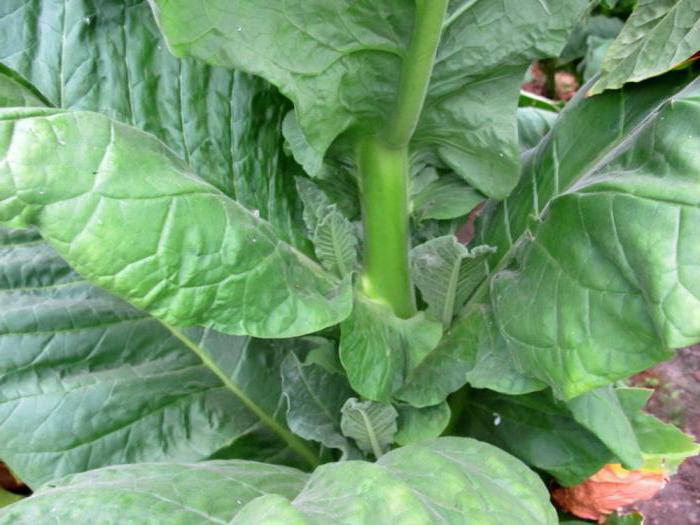

Features of scented tobacco
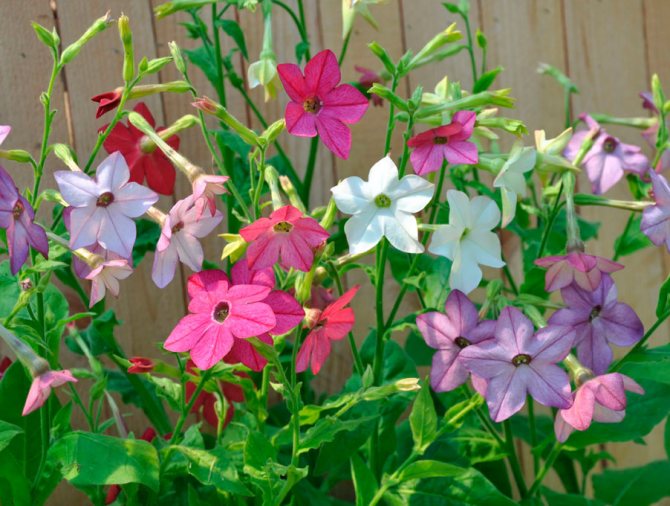

A herbaceous flowering plant, scented tobacco is a member of the Solanaceae family. The height of the bush can vary from 0.2 to 0.9 m. The shoots are erect, the leaf plates are large, and the small flowers are star-shaped. There are glandular hairs on the surface of the entire bush. The color of the flowers depends on the species and variety and can be white, red, yellow, crimson or pink. It is noteworthy that the flowers with a pale color are more smelling. As a rule, the opening of the flowers of such a plant is observed immediately after sunset in the evening. This plant blooms in June and fades in September.In the evening, the aroma of flowers becomes even stronger. Cultivated since 1867.
Tobacco consumption
The main type of tobacco consumption around the world is smoking. The leaves of the plant are rolled into cigars, crushed to fill cigarettes, cigarettes, pipes, processed into chewing tobacco, and ground into snuff.
For the purpose of treatment, untreated tobacco leaves are taken, which are dried in the sun immediately after harvest.
In medicine, tobacco (a plant whose photo you can see in the article) is used as a raw material for obtaining niacin, which is part of many drugs and vitamins.
Care
The tobacco plant, getting to the plantation, requires special care. Every day, it needs to be watered, weeded, loosened the soil around it, and also protect the shoots from a variety of pests. Many gardeners say that tobacco leaves may well protect themselves from excess evaporation. But they are so wide that additional soil irrigation is simply inevitable. If there is not enough moisture, the plant (tobacco) will stop growing and lose its aroma.
By the way, many farmers make so-called baits. Before planting seedlings on the plantation, they fertilize the ground with a bucket of compost or humus - this amount will be needed per square meter. After that, periodically add chicken droppings or infusion of green herbs to the soil.
Two dressings per season will be enough. Tobacco care also includes pinching. And so that it is fragrant and strong, and the leaves are fleshy and large, side shoots are periodically plucked out. This is done when they grow 5 cm. As for the inflorescences, they are removed as soon as they form a bud. If seeds are needed, you can leave one or two flowers - no more.
Manufacture of tobacco products
For pipe and cigarette tobacco, moisture-retaining excipients are added to the crushed leaves: glycerin, apple juice, sugar, honey or mint. Shredded tobacco forms the core of the cigar, around which the whole sheets are arranged in a spiral.
Chewing tobacco is produced in compressed form. It is made from thick leaves and flavors. Snuff is a powder that is also flavored.
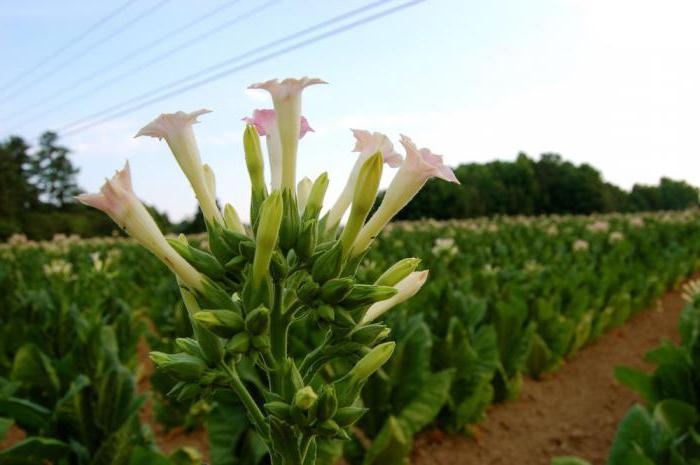

Collection and procurement
Collecting tobacco begins at the end of summer. Harvesting goes until mid-autumn. Start at the top of the plant. There, the leaves are cut off first, since they received maximum light and moisture. After the upper tiers are collected, the lower part has the opportunity to grow and get everything that it lacked - for example, more sunlight.
The cut leaves are placed in a drying chamber. Under the influence of temperature, they lose some of the nicotine. Therefore, the length of stay in such a cell has a direct impact on the strength that tobacco will be able to boast of in the future. The plant is further dried in natural conditions. Leaves are laid out on fabric surfaces in the open air in a place where there is a lot of sunlight. They are covered at night to protect them from insects.
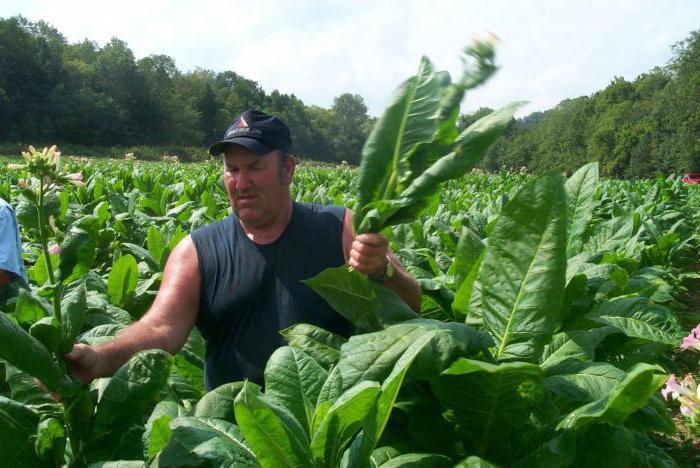

Tobacco plant: chemical composition
Tobacco contains the alkaloid nicotine - a poisonous, toxic substance, the concentration of which is found in tobacco leaves (up to 4%). In addition to nicotine, the leaves contain other alkaloids: nicotine, cornicotine, anabasine, myosmin, nornicotine, as well as essential oils (up to 1.5%), resins (up to 6%), acids (nicotinic, malic, citric, oxalic, chlorogenic - up to 17%), carbohydrates (up to 13%), minerals (up to 10%), sterols, phenolic compounds and other chemicals in small doses. The number of elements can vary depending on the region and growing conditions.
1.Scented tobacco planting and care
1.1 Temperature conditions
Medium to warm content at 18 - 27 ° C.This subtropical plant does not tolerate cold, the minimum allowable temperature during winter dormancy is 10 ° C.
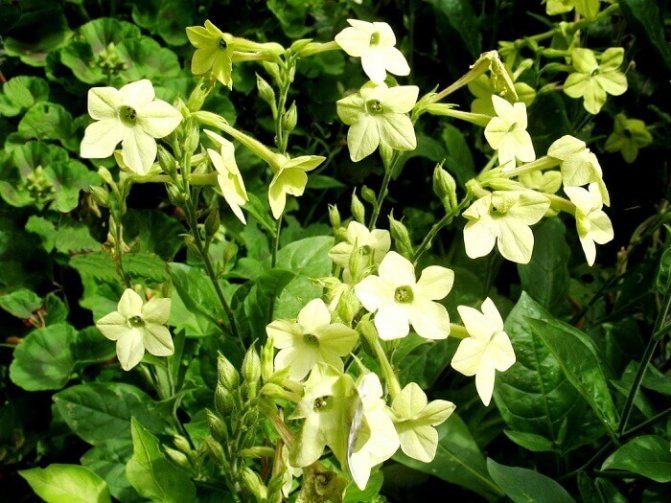

1.2 Growing scented tobacco - lighting
Fragrant tobacco is a long-day plant and blooms only in good light for at least 14 hours a day. Sunny window, light-flooded balcony. Provide the tobacco with at least 4 hours of direct sunlight every day. Blooms reluctantly in the shade.
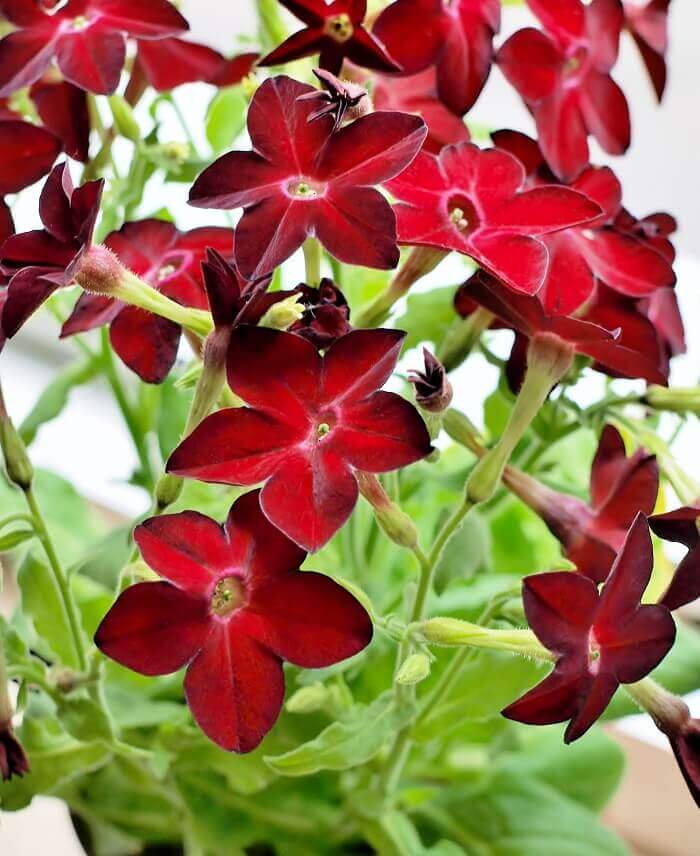

1.3 Care
To extend the flowering time, withering flowers are regularly pinched. Provide this tropical evergreen with warmth, moisture, and plenty of sunshine, as well as support for slender stems. When kept outdoors during a warm period, the plant will produce more flowers. Return the plant to a warm room when the temperature drops below 10 ° C at night. Tobacco needs a winter rest when growth stalls during the winter. Stop fertilizing and water sparingly in winter, but never let the soil dry out completely.
1.4 Substrate
The soil should easily allow moisture and air to pass to the roots of the plant. Sod and leaf humus, peat and coarse sand.
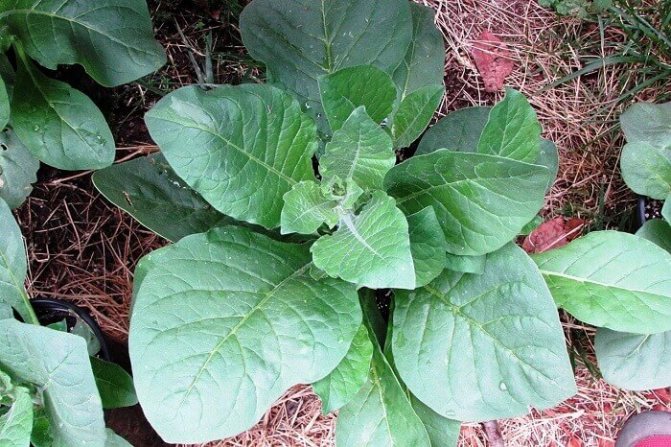

1.5 Potted Scented Tobacco - Top dressing
Every 2 weeks from spring to autumn with a liquid fertilizer with a high phosphorus content, diluted by half.
1.6 Purpose
A very effective decorative flowering plant with a pleasant aroma, the plants look great in pots.
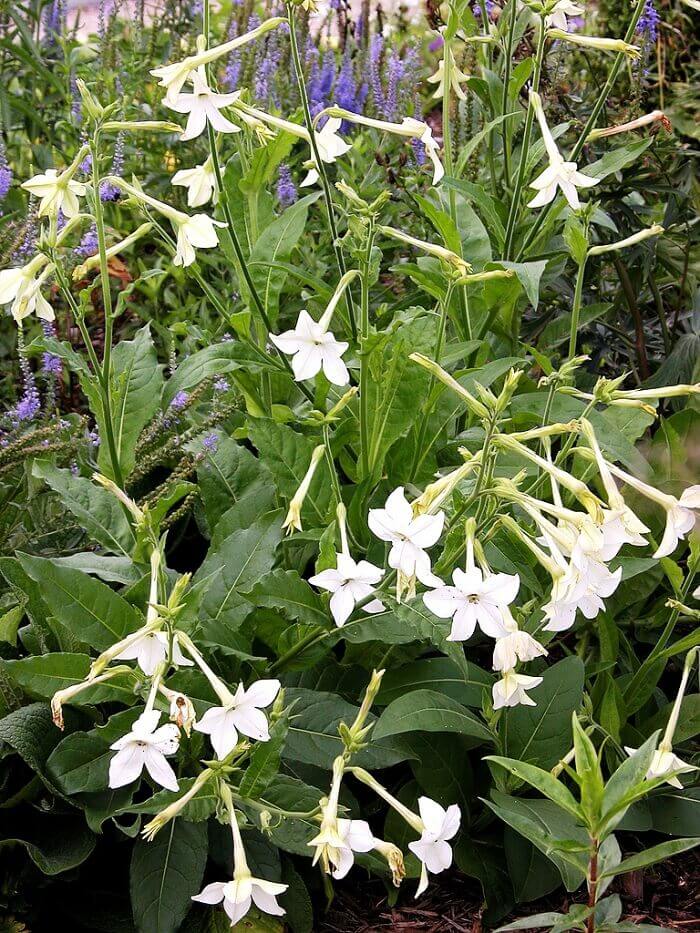

1.7 Flowering time
The flowering is profuse and long lasting throughout the summer.
1.8 Air humidity
Moderate to high (50% or higher). Place the pot on a pallet of damp gravel, or use a humidifier to increase moisture around the plant if the indoor air gets too dry.
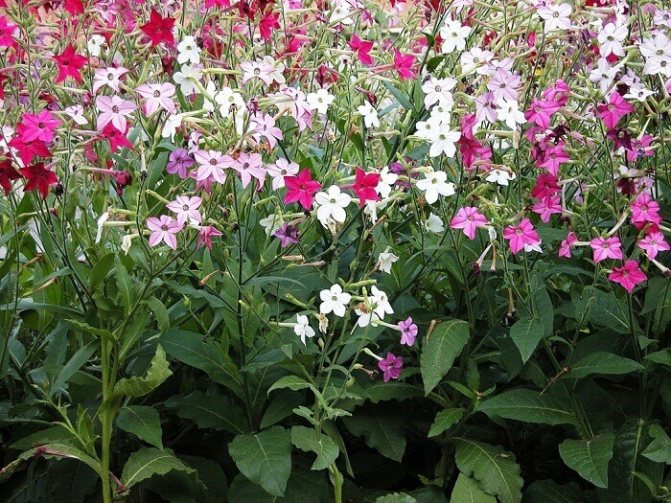

1.9 Soil moisture
Watering is abundant during the growing season, before each subsequent watering, dry the substrate to a depth of about 2 cm. When the summer heat sets in, tobacco leaves often droop and watering should be increased. Reduce watering during winter when growth has slowed.
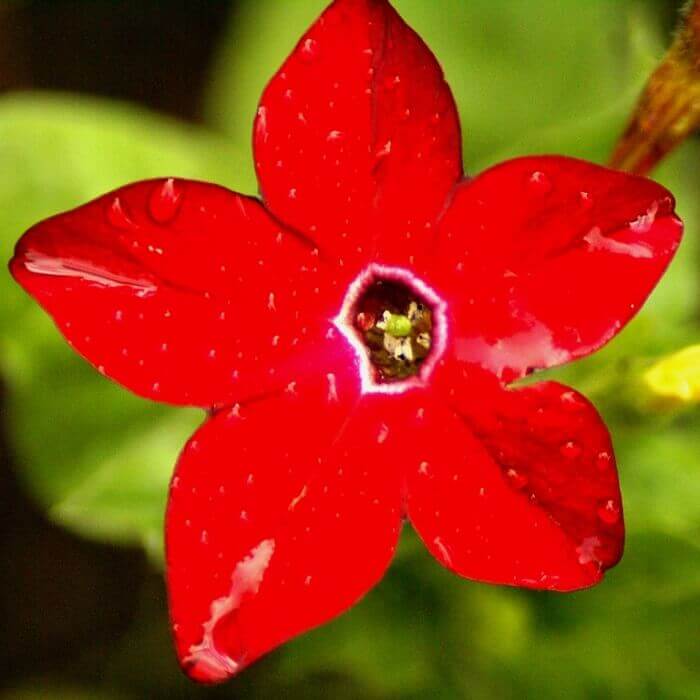

1.10 Transfer
Annual species do not need to be transplanted, since the plants are thrown away after flowering. Transplant perennial tobacco annually in the spring into a larger pot. Use pots with large drainage holes to prevent stagnant water in the root system.
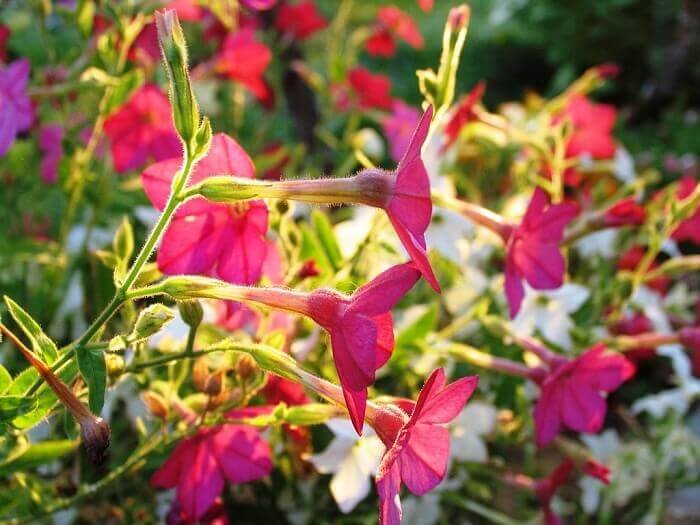

1.11. Reproduction, scented tobacco from seeds
Easily propagated by seeds that are sown in spring. The seeds are slightly pressed into the surface of the soil, without covering them with soil from above. At an air temperature of about 20 ° C, germination will occur within 2 - 3 weeks.
1.12 Pests and diseases
Spider mite. Keep the air humidity high enough to avoid these pests. Aphid.
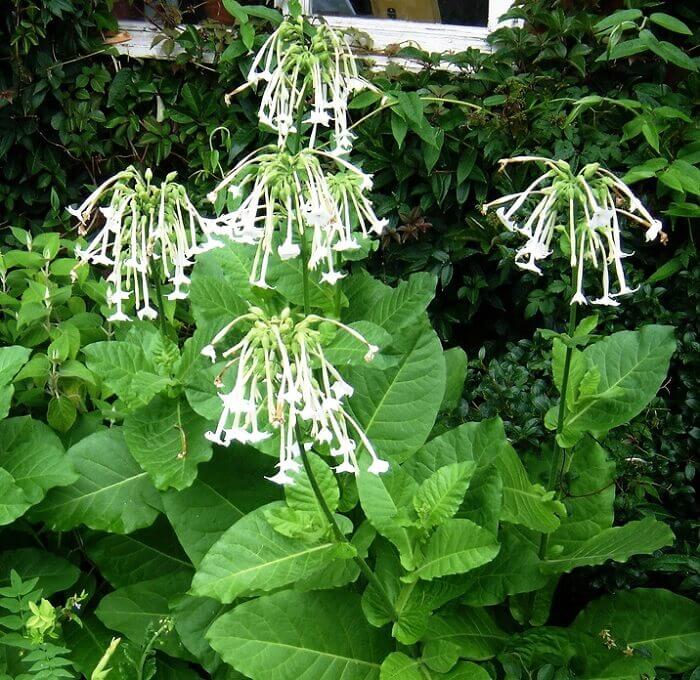

1.13 Note
All parts of the plant are poisonous. Keep it away from children and pets, and use protective gloves when handling tobacco.
Hydroponics .
You may also be interested in:
Fragrant tobacco is an annual plant. Its lush buds contain a palette of bright and large flowers. A fragrant culture is a true summer decoration of every garden plot, despite the slight difficulty in care associated with watering.
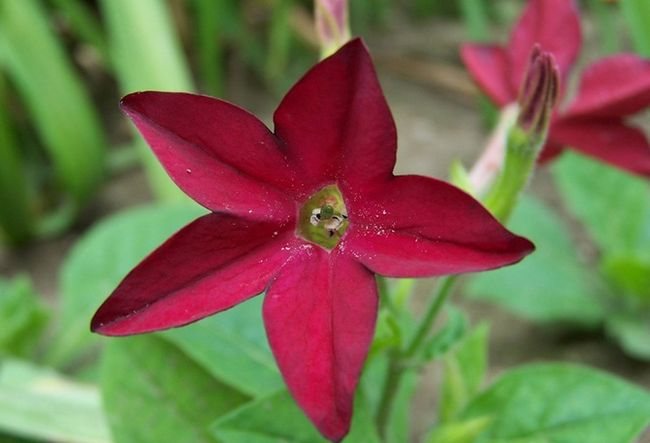

The benefits of tobacco for the body
What is tobacco? Is there any benefit from it? Tobacco has antibacterial, anti-inflammatory and analgesic properties, therefore it is widely used in medicine. There are a number of diseases in the treatment of which tobacco has established itself as an effective remedy for:
- epilepsy;
- malaria;
- skin diseases;
- inflammation of hemorrhoids;
- tonsillitis and other throat diseases;
- rhinitis;
- tuberculosis of the lymph nodes;
- helminths;
- digestive disorders;
- seasickness.
There are facts of a beneficial effect of tobacco even on patients with malignant tumors.
Nicotinic acid obtained from tobacco participates in cell regeneration and metabolism, regulates the level of "bad" and "good" cholesterol in the blood. It promotes vasodilation and improves blood flow, so it is used to treat vascular spasms and in the initial stage of atherosclerosis. Its reception normalizes the work of the nervous and cardiovascular system in patients with coronary heart disease.
Growing
Since the plant has seeds, it is bred with their help. Loose and perfectly plowed soil is required for planting seeds. Tobacco feels great both outdoors and in a nursery. Therefore, it is up to you to decide where you want to plant a fragrant specimen. By the way, the seeds of this plant are so small that you will definitely need a special pistol.
After the seeds are planted in the ground, it must be insulated on top with a layer of straw. If everything is done correctly, then strong young seedlings will appear after a month and a half. You need to wait until they reach 15 cm in height, and transplant the plant (fragrant tobacco) to the plantation.
By the way, this area must be reliably protected from the wind. It is best if it is located on a small slope - in such a place the water will not stagnate: the soil will not be washed out under the influence of precipitation. In the soil itself, it is necessary to add roots from old plants that are available from previous plantings. In addition, it must be thinned with sand. It will be easier for the roots to grow and move in it.
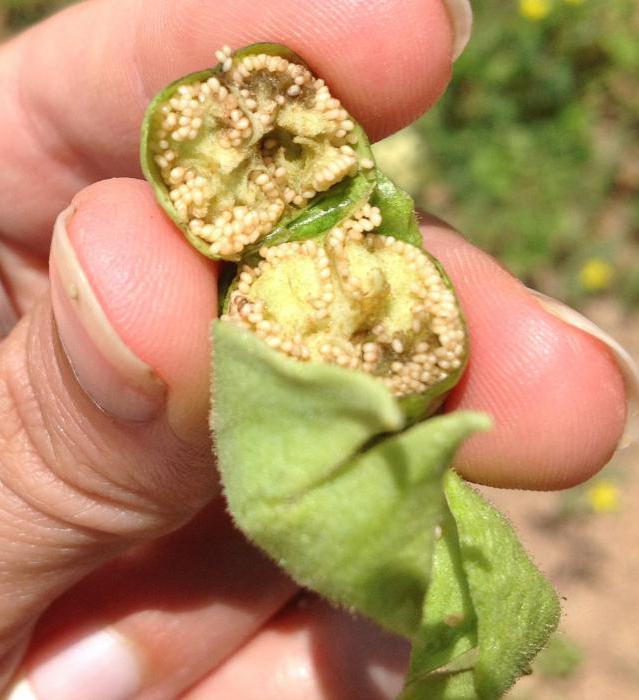

Tobacco in traditional medicine
Even in pre-Columbian America they knew what tobacco is. It was used to treat headaches and nausea, and was also used as an antidote for insect bites.
Today, there are many recipes for the use of tobacco in traditional medicine. For example, to get rid of a runny nose, you can sniff crushed dried tobacco leaves 5 times a day. The enzymes they contain have an anti-inflammatory effect and relieve swelling of the mucous membranes.
To treat tonsillitis, place a couple of pinches of dry leaves under your tongue. Saliva, saturated with enzymes, will not only destroy bacteria in the throat, but also normalize the work of the gastrointestinal tract. But you can neither swallow nor inhale tobacco leaves - this is fraught with toxic poisoning.
Tincture of tobacco leaves is effective in combating skin conditions, including scabies. After a couple of days of regular use, there is a decrease in itching.
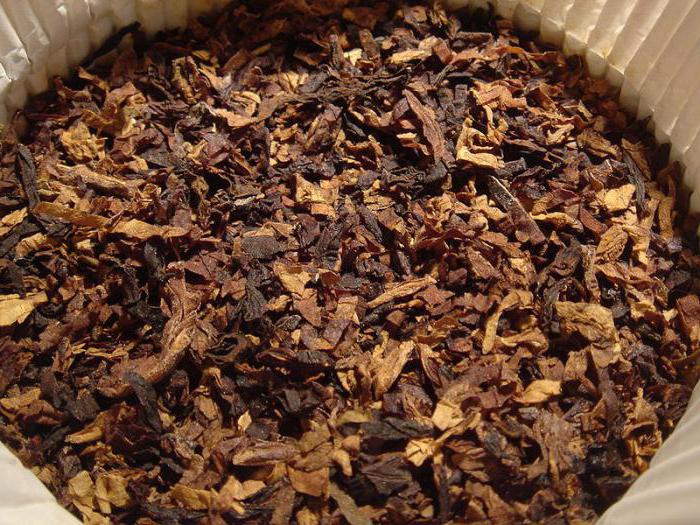

Planting scented tobacco in open ground
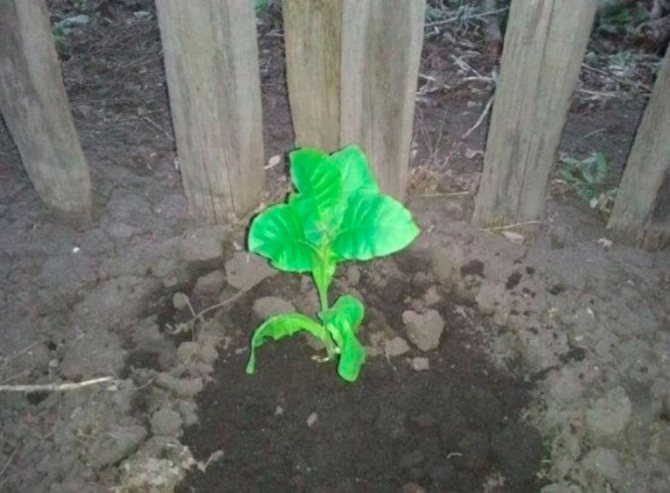

It is possible to plant seedlings of fragrant tobacco in open soil from about the second half of May, however, it is worth considering that by this time the soil should have time to warm up well, and return spring frosts should be left behind.
Before proceeding with planting, the seedlings must be hardened. To do this, for half a month, they are transferred to the street every day. At first, the plants should be in the fresh air for no longer than 1 hour, but then the duration of this procedure should be gradually increased until the seedlings can stay in the garden constantly. After the seedlings are well hardened, they can be planted in open ground.
Landing features
To plant scented tobacco, you should find an area that will be protected from direct sunlight and from strong gusts of wind. Ornamental species do not impose special requirements on the composition of the soil, however, it is very important to take into account its moisture and nutritional value. If the soil is poor, then even in the autumn time it is necessary to dig it up, while humus or compost must be added to it, as well as drainage material, if necessary.
When planting seedlings in open soil, it should be borne in mind that the distance between the bushes must be at least 0.2–0.3 m. If you grow tall varieties, then the distance between plants must be increased, since these plants are large enough and in height they can reach almost 100 centimeters. At first, the seedlings will stretch to their full height, after which they will creep along the surface of the earth.
Before planting, a small amount of superphosphate must be added to the hole, which must be combined with the soil. Then the plant is gently poured into it along with a lump of earth, the hole is covered with soil, the surface of which must then be compacted. The planted plants must be watered.
The dangers of using tobacco
What is tobacco and what harm can it do to the body? The nicotine contained in it requires caution in treatment, because it can cause severe poisoning. The main symptoms: headache, dizziness, weakness, fever, burning in the mouth, vomiting, diarrhea, increased or slowed heart rate, salivation, cooling of the extremities, constriction of the pupils, in some cases hallucinations. Some of these symptoms require immediate medical attention. Even before the ambulance arrives, you need to flush your stomach.
The poison of nicotine, when ingested in an amount of 0.5-1 mg per 1 kg of weight, can cause coma or paralysis of the respiration and heart and, as a result, death. In this effect, even potassium cyanide is inferior to nicotine, the lethal dose of which for a person is 1.7 mg per 1 kg of body weight.
Due to the toxic effects of tobacco, its use is prohibited for children, pregnant and lactating women. Dangerous even for a healthy adult is tobacco grown and harvested on their own.
Tobacco smoke poisoning has the most damaging consequences. The nervous and respiratory systems are affected, blood vessels are clogged with "bad" cholesterol, which provokes atherosclerosis and coronary heart disease. Toxins negatively affect the liver, from which it grows in size. Tobacco smoke poisons the sex glands, impairing fertility.


Growing scented tobacco from seeds
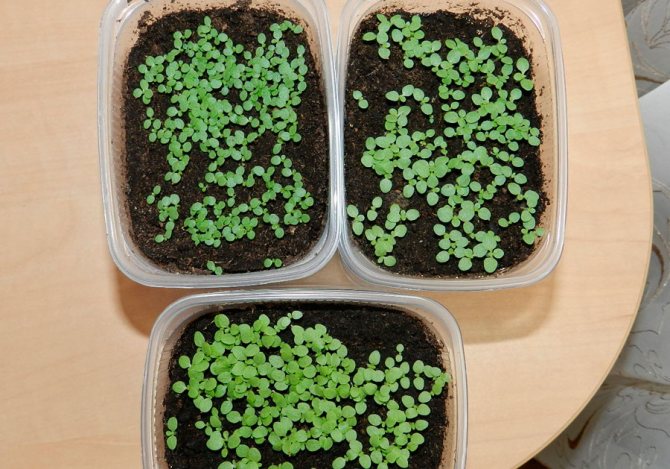

What time is sowing
Fragrant tobacco, which is an annual, is one of the rather thermophilic plants. In this regard, experienced gardeners recommend growing it exclusively through seedlings. Sowing of seeds falls on the last days of February or the first days of March.
Sowing features
For sowing scented tobacco, you need to prepare not very deep containers. And also take care of the soil mixture, which should include peat, humus and garden soil (1: 1: 1). Before sowing, for swelling, the seeds must be wrapped in a moistened cloth for several days, however, it must be remembered that the seeds should not hatch. The seeds are quite small, so they are carefully distributed over the surface of the soil mixture, while they are not required to be embedded in the substrate or sprinkled with soil mixture. Crops must be moistened from a sprayer, and then the container is covered with glass or foil. Then they are removed to a warm enough place (20 to 22 degrees). The first seedlings, as a rule, appear after 1.5–2 weeks, as soon as this happens, the shelter must be removed, and the containers must be transferred to a well-lit windowsill.
Growing seedlings
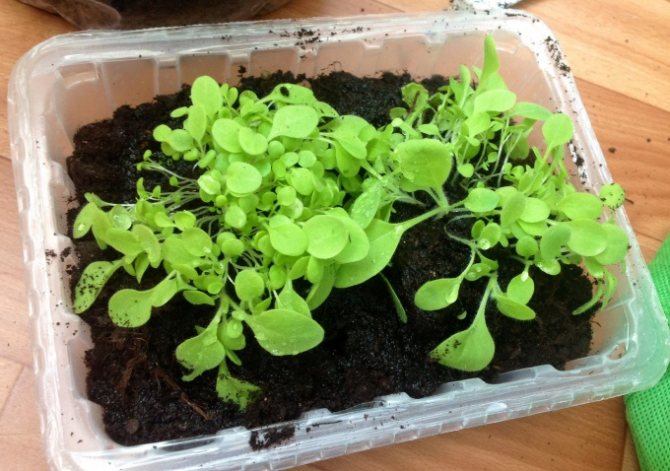

Seedlings will need systematic moderate watering, and you will also need to very carefully loosen the surface of the substrate. The picking of seedlings is carried out after they have formed a pair of true leaf plates.
Picking
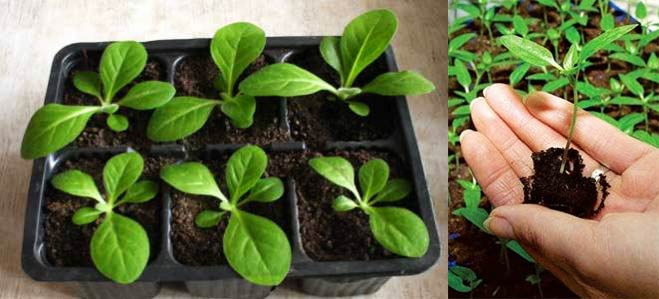

After the seedlings are well watered, the seedling is very carefully pulled out of the container along with a lump of earth and planted in an individual cup. After the rooting of the unpicked plants, it is necessary to pinch their tops, which will allow a more lush bush to form.
Household use
Nicotine is no less toxic to insects than to humans. In everyday life, tobacco will help you get rid of moths. Place dry tobacco leaves in the closet where the fur products are located - it will protect your belongings from pests.
Gardeners use tobacco as a means of protecting crops and fruits from insects. To do this, you need to prepare an infusion or decoction of dry tobacco leaves and spray it on plant leaves. This product does not burn the leaves and protects them from aphids, caterpillars, thrips, onion and cabbage flies. By the way, the use of tobacco against insect pests began in the 16th century.
In gardening, tobacco powder, ground to a dusty state, is also widely used. Tobacco dust is applied to the soil as a fertilizer. Penetrating into the soil, it is able to improve the quality and quantity of the crop due to the phosphorus, nitrogen and potassium that it contains.
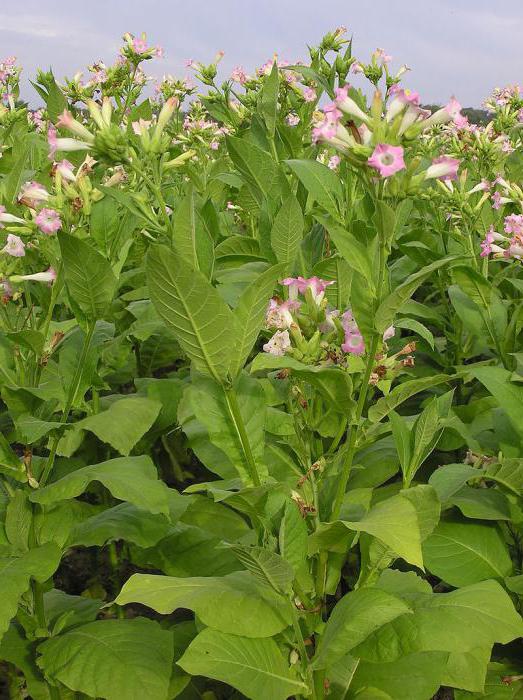

Caring for scented tobacco
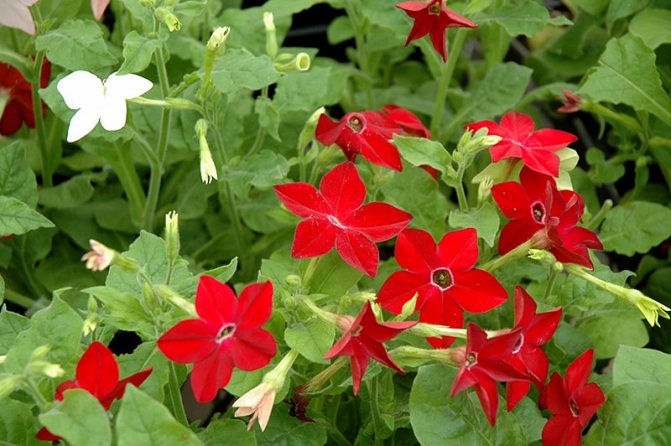

There is absolutely nothing unusual or complicated in the cultivation of scented tobacco in the garden. This plant only needs to be watered, weeded, fed, loosened, and protected from pests and diseases if necessary. In order for the bushes to always look fresh and well-groomed, you need to regularly cut off the flowers that have begun to fade.
Such a culture must provide abundant and relatively frequent watering. In a hot and dry period, this procedure is carried out daily. But if summer time turned out to be rainy, then you do not need to be overzealous with watering.
If scented tobacco grows on fertile soil, then you will not have to feed it at all. If it was planted in poor soil, then the flowers will need to be fed 2 times throughout the growing season: immediately after the start of budding and as soon as the bushes bloom. Too much nitrogen should not be added to the soil, as this will cause the bushes to intensively grow green mass to the detriment of flowering. Fertilizers are dissolved in water, with which flowers are watered.
Pests and diseases
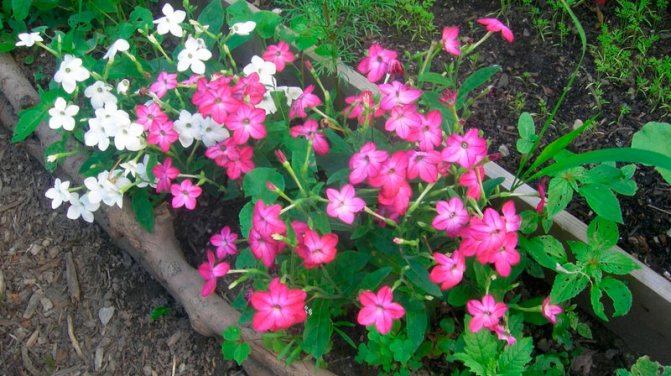

This crop is highly resistant to various diseases and pests. It contains in its composition a large amount of phytoncides, which have a deterrent effect on harmful insects. Fragrant tobacco can protect not only itself from pests, but also plants that are grown in the immediate vicinity.
After flowering
In the autumn, it is necessary to select several of the most spectacular bushes. They should be removed from the soil and transplanted into pots, which are then brought into the house. It is necessary to shorten all the stems by 1/3 part. The pots are removed in a well-lit place, watering is carried out as the soil dries up. When warm weather sets in in spring, the bushes are transplanted back into open ground.
From the history of tobacco
What a tobacco plant looks like was learned back in the 1st century. The smoking tradition dates back to those times. American Indians are considered to be the first to use tobacco for smoking purposes, and this ritual had a purely religious significance. An important custom was the smoking of one long cigar by several people, who thus emphasized friendly intentions towards each other.
When Christopher Columbus "discovered" America, he first became acquainted with the phenomenon of tobacco smoking. The natives gave him tobacco leaves, and two of his expedition learned to smoke them. However, it was not Columbus who spread tobacco throughout Europe, but the French traveler monk André Theve, who in 1555 brought tobacco seeds from South America to France. And already in 1560, the French ambassador Jean Vilman Nico, after whom the plant was named, brought snuff from Portugal. He proclaimed it a panacea for all diseases, especially for migraines - and the court of Catherine de Medici quickly spread the fashion for sniffing tobacco.
The primitive tribes of the Amazon used wild tobacco as a powerful poison, as a pain reliever during childbirth, and as a cure for certain diseases.
The Caribbean natives used a Y-shaped reed pipe, which was called "Tobago" or "Tobaca" - this is how the Spanish version of the name of the plant appeared, which also passed into the Slavic languages.
The largest tobacco plantations belonged to Spain. At the end of the 16th century, Portugal, Holland and England began to compete with it. Tobacco smoking quickly won the sympathy of Europeans, and by the beginning of the 17th century, tobacco was used throughout the world.
Smoking tobacco - description
Tobacco is an annual herb that grows to a height of 3 m. The stem of tobacco hardly branches. The alternate whole leaves in different varieties of Virginia tobacco can be narrow-lanceolate and broad-ovate in shape, and their number on one plant can vary from 16 to 60. The lower leaves are descending, the base of the leaf is semi-petiolate, the surface is resinous, fleecy. Reddish or pink funnel-shaped tobacco flowers are collected in narrow apical paniculate inflorescences. The main economically valuable features of tobacco are the size of the surface and the thickness of the leaf plate. Tobacco is cultivated in 84 countries of the world.
- Planting muscari in the ground
Sowing dates of scented tobacco seeds for seedlings
Every gardener and summer resident who decides to start growing crops at home may have a question about when to sow scented tobacco seeds for seedlings, in what month. The optimal planting time is the second half of February, March, April.
When choosing the right time, it is very important to focus on the climatic conditions and the characteristics of the region in which you plan to grow. In the Central lane (including the Moscow region) - you can plant in the second half of March, in Siberia, in the Urals, in the Leningrad region - in early April, in the South of Russia - in mid-late February or early March, in the Volga region - it is better to plant in the middle and end of March.
You can also choose the optimal time for sowing scented tobacco for seedlings according to the lunar calendar of 2019:
- Favorable days for the procedure: in February - 6, 7, 8, 11, 12, 13, 14, 15, 16, 17, 21, 22, 23, 24, 25, in March - 12, 13, 14, 15, 16, 17, 19 , 20, in April - 6, 7, 8, 11, 12, 13, 15, 16, 17, 29, 30;
- Unfavorable days: in February - 4, 5, 19, in March - 6, 7, 21, in April - 5, 19.
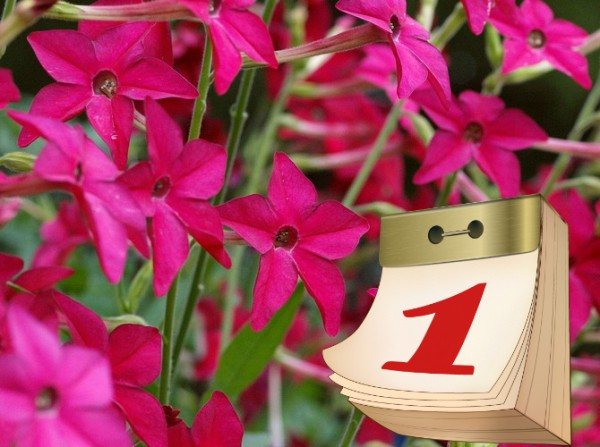

Reproduction
Summer plant is a good, abundant self-seeding, but such seedlings are not effective and bloom very late. The simplest and most convenient breeding method is seedling. For numerous seedlings, seeds are germinated at a temperature of 18 to 20 degrees, “in greenhouse conditions” under glass or foil. After the first shoots appear, the temperature is lowered by a couple of degrees. Young sprouts must be watered carefully, without overflowing, as this can destroy them. When the first leaves appear, they must be transferred to individual containers. Before planting in the ground, the sprouts need to be hardened in the fresh air.
Conditions for growth
Fragrant tobacco is a rather unpretentious plant. It is able to germinate almost anywhere, its flowering will not be radically different. It germinates easily both in direct sunlight and in partial shade, under the crowns of trees and tall shrubs, it will always bloom and have a pleasant aroma, even under the scorching sun in arid climates. You should not plant it on the shady side, where the sun never comes. The soil is chosen for planting from a range of quality garden soils. He does not need feeding before planting, this can even aggravate his development and growth. But if the soil is depleted after winter dry frosts, a month before planting it is worth enriching it with useful minerals by introducing humus or compost into the soil, plus add some drainage.
Fragrant tobacco: photo of flowers, recommendations for growing
In this case, the lower row of leaves from time to time, approximately with a frequency of a week or two, should leave the bush. The bush should be juicy, green, full of energy.
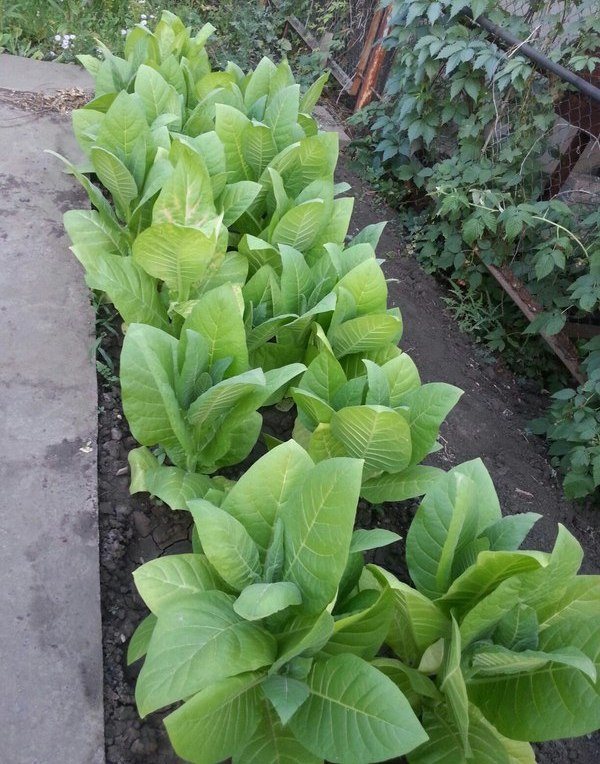

Once the tobacco sheets reach A4 size, you can think about collecting them as well.
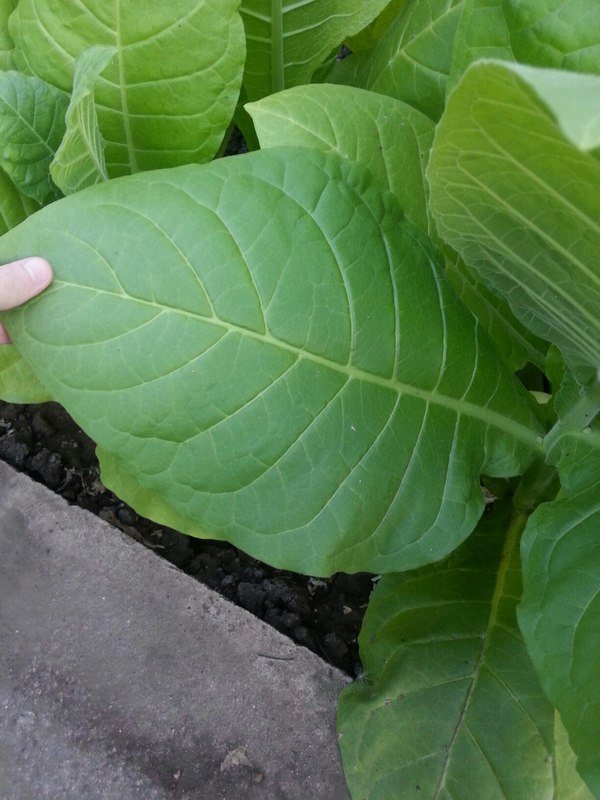

You also need to pay attention to the color of the leaf. It should be dark green, ripe. Don't wait for the leaves to curl in place and turn yellow. The drying and fermentation process is a completely different topic. The leaves should be juicy, green, ready to give their vital energy to all those who in the future want to draw out the sunny notes of a hot summer from them. In principle, this is where the process of growing cigar tobacco ends. Briefly, but better than nothing. Further on, how to roll, or rather even make cigars.
Testimonials
The variegation of the flower and the unpretentiousness made him the favorites of flower growers. The happy owners of this handsome man share their admiration and talk about some of the difficulties in cultivating an annual.
Larisa Petrovna “I met the plant only in the fall and immediately fell in love with it. I was lured by a motley picture on a package with seeds. There were no problems with sowing and sprouting. I planted seeds on seedlings in March, and already in May transferred them to a flower bed. In July, the bushes began to delight with multi-colored, fragrant buds, reminiscent of small stars.
For the sake of experiment, I cut it off for a bouquet - they stood in a vase for a long time, filling the room with a pleasant aroma. Fragrant tobacco has only one drawback - it is that the plant is grown as an annual. I want to dig up bushes in the fall and transplant them into flowerpots. I hope that in the warmth of my home, my flowers will delight me all winter. "
Svetlana - novice gardener “I saw this handsome man in the photo on the Internet. I immediately liked the interesting color of the buds - a light green shade. And the name surprised at all - fragrant tobacco. I found seeds in a flower shop, chose the brightest varieties. As a beginner in the flower business, I strictly followed the manufacturer's instructions. And voila! My flower bed beckons all the neighbors with its diversity, and the heady aroma allows you to relax at the end of a hard day. "
Nikolay “I am not a fan of bouquets on the estate, but it is tobacco that I regularly plant in the beds. The thing is that the plant lures the Colorado potato beetle to itself. This means that potato bushes are safe from this pest. And it is easier to collect a beetle from flowers ”.
Ekaterina “And I have a negative result of my acquaintance with this flower. In the first year after sowing the seeds, only two or three bushes sprouted in the open ground, and even those were weak and painful. The next year, she sowed seeds for seedlings. But in the process of flowering, it turned out that the buds did not emit any aroma. In general, I decided not to plant this flower again ”.
Winter storage
If you do not want to disturb the plant at the end of the season, with the onset of cold weather, you should dig out a bush and transplant it into a pot or spacious container (see photo). It is necessary to shorten all shoots by one third and put them in a warm room. Water if necessary throughout the winter, and in the spring, when the soil warms up to the desired temperature, plant it back in its original place.
Fragrant tobacco grows well in partial shade and in places with diffused light, in the shade of bushes and trees. Looks good both in rockeries and alpine slides. Grows well in containers and flowerpots.
Contraindications
The plant also has them. Tobacco, for example, is not recommended for the treatment of young children, pregnant women, and new mothers. And alcohol tincture from it can adversely affect the health of even a strong adult. By the way, the situation is aggravated when self-grown tobacco is used for its preparation.
The first signs of poisoning are as follows: headache, hallucinations, dizziness, fever. If you experience these symptoms, call an ambulance immediately. Even before the arrival of the team, you can try to flush the stomach yourself. And remember the main thing - it is better to consult a doctor before using any traditional medicine!
Diseases and pests
Fragrant tobacco is immune to most pests. This variety of flowers is considered a phytoncide that can scare away harmful insects, both from themselves and from their neighbors. However, there is a disease that can harm the culture.
Downy mildew (downy mildew) is a disease that occurs with high soil moisture. It affects the foliage of bushes. On the outside, the leaves are covered with vague spots, which eventually merge into one lesion. Subsequently, the foliage dries, curls up and falls off. The buds can also be affected by the disease. Powdery mildew can be fought with several methods:
- Ash tea leaves. For 3 liters of boiling water, add half a liter of the hall. Stir. Pour into a 10 liter container and add cold water.
- Garlic broth. 75 g of chopped garlic is poured over 10 liters of water. Bring to a boil. The affected plants are cooled and treated by spraying.
- Iodine milk. Add 10 drops of iodine (5%) to 1 liter of pasteurized milk, dilute in 10 liters of water.
The presence of sick neighbors in a flower bed can infect tobacco with diseases such as bacterial hazelnut, root rot, and fungus.
Among pests, an annual is often affected by an earthen flea. You can get rid of the insect by sprinkling ash on the plant. Several treatments can be carried out per season. Sometimes you can find on the foliage of the Colorado potato beetle - it is harvested by hand. If the flower infects aphids, treatment with ammonia will help.
Interesting! The seeds have a good germination retention rate. There were cases when seeds of five years ago gave 100% germination.
Growing seedlings
Usually the seeds of this flower are planted for seedlings from mid-March to the first weeks of April. Fragrant tobacco gives the first shoots in about 9-13 days, the time of their appearance depends on the illumination and temperature of the room where the seedlings are located. Here are the main stages of growing this annual plant in seedlings:
- Containers prepared in advance and filled with soil are well spilled with water at room temperature.
- The tobacco seeds are very small. They can be mixed with fine washed river sand and sprinkled with this mixture evenly on the ground, or simply sprinkled gently on the surface of wet soil, then gently press them with your palm.
- The seedling boxes are covered with a sheet of transparent organic glass or foil, after which they are placed in a warm and well-lit place, with a temperature of + 18 ° C to + 20 ° C.
- The soil, before pecking the seeds, is moistened with a spray bottle once every two days.
- The seeds will sprout in 9-14 days and will grow very quickly. At this time, it is advisable to lower the temperature to + 16-17 ° C and water in moderation.
- The first real leaf of fragrant tobacco is thrown away somewhere in 20 days.
- After the first pair of true leaves appears, you can start picking the seedlings.
- About a month after the pick, the seedlings will get stronger, and a good root system and large leaves will form. During this period, watering should be done rarely, as the soil dries out.
Multicolored varieties
In nature, scented tobacco is found only with white flowers. Modern breeders have created many varieties, the flowers of which are colored in raspberry red, lemon green, lilac and pink shades. Here is a list of some popular and interesting varieties in color:
- "Night fire" - a bush about 60 cm high, with flowers of an intense crimson color.
- "Green light" - grows up to 50 cm, flowers of a pleasant lemon shade.
- "Fragrant Blue Harbor" - the flowers are painted in deep blue, and the bush can grow up to 60 cm.
- "Sunny Bunny" - can grow up to 60 cm, blooms with rich yellow flowers.
- "Lilac fog" - decorated with lilac flowers, height - 60-75 cm;
- "Ringing bell" - the owner of a high stem, up to 90 cm, flowers are painted in pale pink.
How varied in color fragrant tobacco is, the photo below clearly demonstrates.
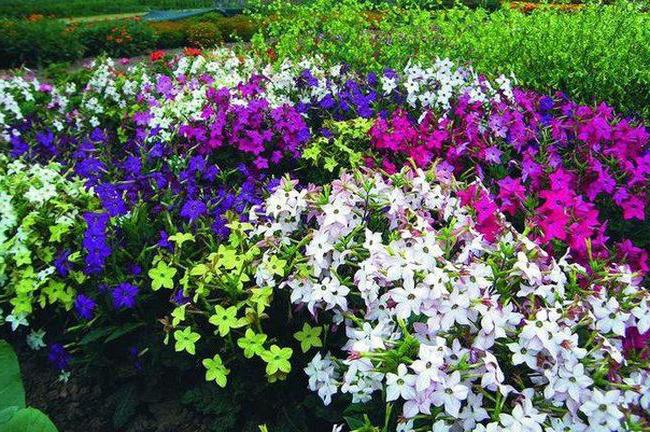

Mr. Dachnik recommends: scented tobacco - fungicide in the garden
Fragrant tobacco is a beautiful and useful plant for a summer cottage. The scent attracts bees, which is important for insect-pollinated crops.
Also, the plant successfully defeats the Colorado potato beetle. Tobacco and potatoes belong to the nightshade family. A dangerous insect moves to a fragrant flower, but the phytoncides in its leaves are poisonous. Pests die after eating greens.
To get rid of Colorado beetles, experts advise planting scented tobacco around the perimeter of the site a few days before potatoes. The flower is not addictive to pests like chemical poisoning agents. Annual planting together for three years will help get rid of dangerous insects.
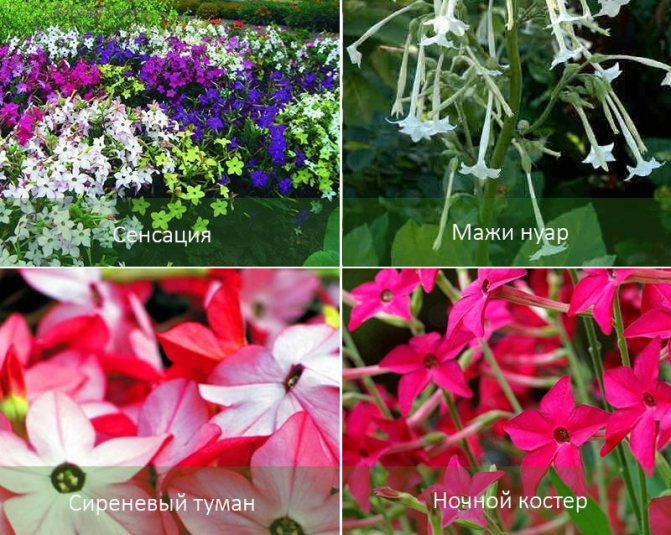

Fragrant tobacco belongs to the unusual fragrant flowers that create a unique atmosphere of the garden. Combine well with other plantings. They delight with their appearance all summer long, do not require complex care.
Description of the plant, popular varieties and varieties
The plant has absolutely no resemblance to its famous namesake.
Fragrant tobacco looks like this:
- Erect, slender, branched stem up to 80 cm tall.
- Long, broad leaves with pointed tips grow at the bottom of the stem.
- Smaller leaves are placed above.
- The flowers are large enough (6-8 cm in diameter), regular, non-double, in the form of stars.
- In the main species, they are white. Opened in the evening or on cloudy days. The aroma is very strong, one might even say harsh.
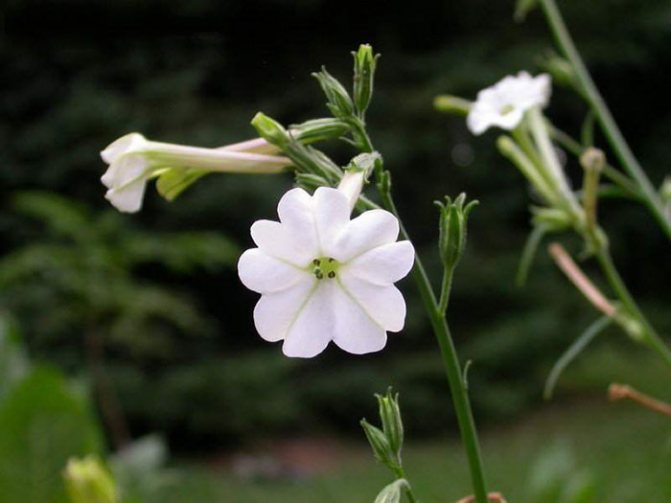

Fragrant tobacco has a strong aroma
Common varieties and hybrids:
- Winged - the variety is endowed with flowers of white and pink color. Fragrant.
- Green light - flowers are pale green. In the evening they spread a very strong aroma. The combination of this variety with other, bright colors looks great on the flower bed.
- Aroma Green - this variety is characterized by green, drooping flowers of an unusual bell-shaped form. A very fragrant plant.
- Ringing bell F1 - the shape of the flowers of the hybrid resembles Aroma Green, but their color is red. The aroma is weak.
- Delight is a hybrid endowed with high drought tolerance. Planting it outdoors is recommended mainly in the background of flower beds, since the plant is very tall (more than a meter) and grows quickly. From summer to autumn, it is covered with a lot of crimson flowers. The aroma is not as bright as that of the main species.
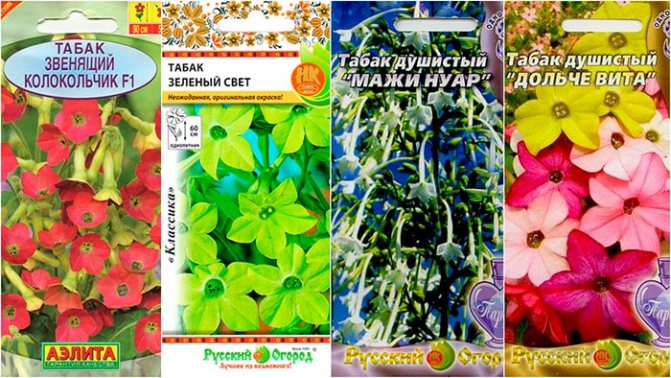

Fragrant tobacco seeds
- I smear Noir - the flowers are snow-white. It is believed to have the most intense aroma. Almost no care is required.
- Dolce Vita F1 - the buds of this hybrid open in the morning and close in the evening, so you can take great photos of the plant in daylight. The color of the flowers is varied: blue, purple, green, white, pink, red. Therefore, the cultivation of Dolce Vita is possible in any flower arrangement.
Attention! Reproduction of hybrids by seeds collected from their flower beds is undesirable. The plants obtained from them do not retain their parental qualities.
Sun or shade?
This question plagues many aromatic tobacco growers. Planting and leaving, both in the sun and in light shade, are about the same.
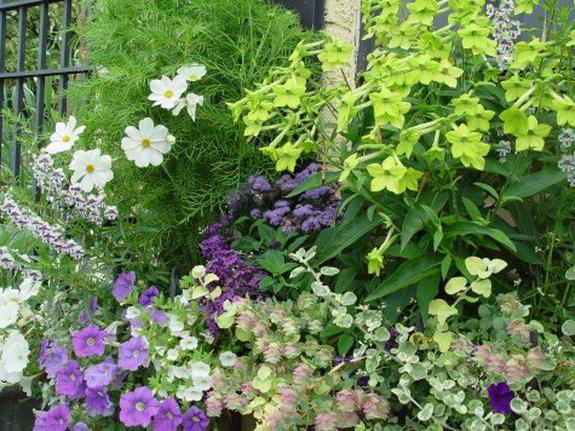

The only difference will be in the amount of water that will need to be watered for the plants. It is best not to plant these flowers in areas that are illuminated by the sun all day, as well as open to all winds. Flowering, and the very appearance of such specimens, most likely, will not please you. The flowering of scented tobacco begins in mid-June and lasts until mid-September, although many gardeners enjoy it until the autumn frosts. And if this plant does not tolerate spring frosts, then in the fall a strengthened bush can withstand temperatures up to -40C.
Annuals with a pronounced aroma
The beauty of annual flowers is that you can enjoy their smells in the year they are planted. With the onset of the new season, you can change the exposure, experimenting with fragrances until you find the desired bouquet. What fragrant annual flowers are most often cultivated in gardens and backyard plots?
Mattiola two-horned or night violet
The inconspicuous appearance of the small flowers of Matthiola bicorn can alienate the novice gardener. Indeed, this cruciferous plant does not shine with beauty. Its strength lies in a spicy sweetish scent that spreads in the evening hours around the blossoming tiny flowers. The enchanting scent of matthiola bicorn remains throughout the night. No wonder this annual has another common name - night violet.
The flowering of Mattiola bicorno lasts throughout the summer. Even the first frosts are not terrible for this unpretentious plant. The flowering period of an individual 4-petal flower lasts no more than five days, after which a fruit is formed that has the shape of a pod with two peculiar horns located at its top.
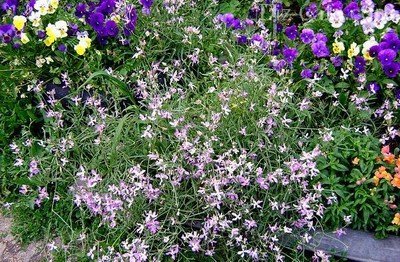

The inconspicuous flowers of the night violet against the background of a bright flower garden begin to savor with the onset of dusk, filling the air with an unforgettable aroma
The night violet is sown in early spring directly into the ground. The planting process can be divided into several stages, maintaining certain time intervals between them (12-15 days). Although Matthiola Bicornus prefers sunny locations, it can also be grown in shaded areas of the garden.
Mattiola gray-haired: blooms beautifully and smells good
Gray-haired mattiola, which is also called levkoy, is fundamentally different from its two-horned namesake. This plant is valued not only for its honey aroma, but also for its large double flowers that bloom in the form of a cap at the top of woody or slightly branched stems. The plant can reach a height of 80 cm.For those who do not like giants, dwarf varieties have been bred, the height of which does not exceed 20 cm.The flowers of gray-haired mattiola can be simple (4-petal) and double (70-petal), and the latter are capable of blooming within three weeks.
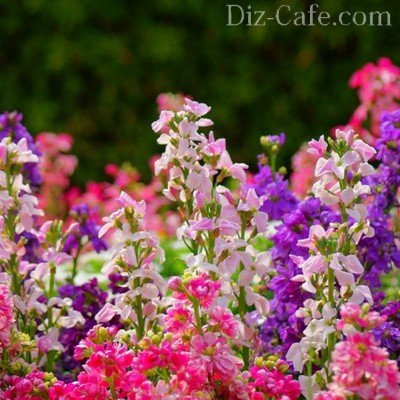

Levkoy or gray-haired mattiola is unusually beautiful and surprisingly fragrant. The pleasant smell intensifies in the evening and lasts until the morning.
Lush double flowers do not produce seeds. Seed material is obtained only from simple flowers. From half of the collected seeds, plants grow with simple flowers, and from the other half - with double flowers. Levkoe varieties have been developed, in which this ratio is increased in favor of plants with double flowers. In order for the gray-haired mattiola to bloom in the year of sowing, it is necessary to sow seeds for seedlings in March.
Fragrant tobacco - delicate aroma in a flower bed and in a pot
Another striking representative of odorous annuals grown by amateur gardeners. Early varieties of fragrant tobacco were distinguished by long stems and white gramophone flowers that opened in the late afternoon. Later, more compact varieties were bred, differing from each other not only in the height of the plant, but also in the color of the flowers.
Now you can buy fragrant tobacco, the flowers of which will have a raspberry, red, pinkish or lemon-yellow tint. Moreover, in the daytime, the flowers do not close. However, plants with white flowers have the most pronounced aroma. It is best to grow scented tobacco through seedlings to ensure early flowering of the plant. Seedlings are afraid of spring frosts, so tobacco seedlings are planted in a permanent place with the onset of real heat. The plant feels equally well in areas illuminated by sunlight or in partial shade.
Some growers keep the scented tobacco until the next season by replanting the plant in a flower pot before frost.The transplanted plant is brought into the house, where, after a short rest, it begins to bloom again and fill the home with the most delicate aroma. With the arrival of spring, the dug out plant is returned to its original place.
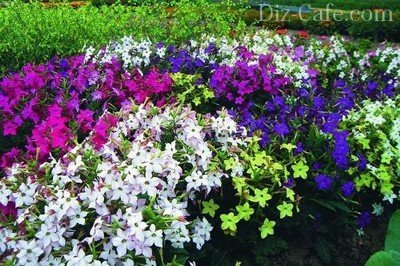

Fragrant tobacco is able to conquer the amateur gardener not only with its honey aroma, but also with large flowers, similar in structure to gramophones.
To prolong the flowering of scented tobacco, it is necessary to promptly rid the plant of dried flowers. This measure will serve the intensive formation of new buds.
Sweet peas - fragrant two-meter vines
Among climbing garden plants, sweet peas are famous for their pleasant aroma. At the moment, there are about a hundred species of this plant, and the number of varieties reaches a thousand. In this varietal abundance, you can find plants with small and large (6 cm in diameter) flowers that have a variety of shades of the color palette. The smell of sweet peas is most pronounced in the early varieties. Hybrids bred later exude weaker aromas, but have high decorative properties.
Two-meter lianas, clinging to the supports with antennae, perfectly cope with the task of vertical gardening of arbors, verandas, pergolas, hedges, etc. In small gardens, this plant is used to screen areas given for growing vegetables. Low-growing (dwarf) varieties, reaching a height of no more than 30 cm, are planted in containers or hanging baskets.
Delicate sprouts of sweet peas do not tolerate transplanting well, therefore it is recommended to sow the seeds directly into the heated soil. Three peas are thrown into the hole, which are pre-soaked in warm water for a day.
Recent Entries
Rose Petal Jam and Its 7 Health Benefits You Likely Didn't Know About What Fruit Are You According to the Zodiac Sign 11 Best Grape Varieties That Will Help You Create Unique Homemade Wine
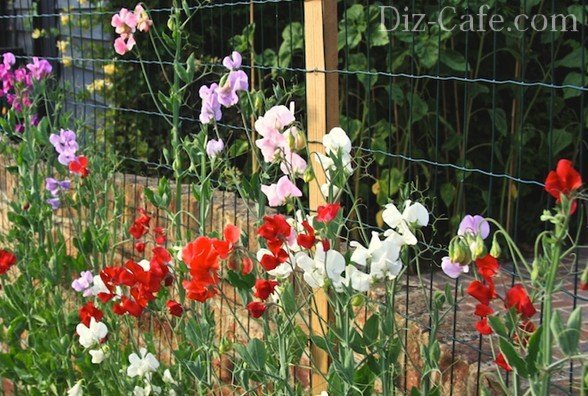

An airy wall of sweet peas looks elegant and sophisticated. Under cover of darkness, each flower emits a delicate aroma that attracts all living things
Fragrant mignonette: a proven scent for centuries
Fragrant mignonette has been cultivated in gardens for a long time. The love scenes of many novels written in the 19th century unfold against the backdrop of the sweet and heady scent of mignonette. Modern flower growers find a place in the garden to plant this amazing plant. At the same time, gardeners are attracted not by the simple beauty of ordinary-looking greenish mignonette flowers, but by their delicate fragrance in the evening and at night. Although breeders managed to get decorative varieties of this fragrant plant with a more attractive color of inflorescences:
- red-green (Red Monarch);
- yellowish red ("Waving");
- pinkish copper ("Ruby");
- light green ("Giant");
- dark brown ("Victoria");
- intense red ("Goliath").
In open ground, the seeds of fragrant mignonette are sown in the last decade of April or in the first week of May. Seed germination is influenced by weather and soil moisture. Under optimal conditions, mignonette shoots can be seen in one to two weeks. The plant loves freedom, therefore, frequent shoots are necessarily thinned out, maintaining a distance of 15-20 cm between adjacent shoots.
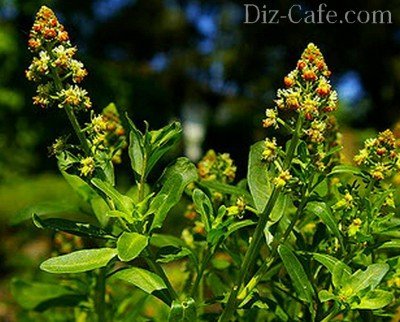

Fragrant mignonette is a time-tested aromatic plant. Prized for the sweet specific smell of small flowers
Reseda loves open spaces, well lit by the sun. In dry summers, caring for mignonette consists of abundant watering. Fertilizing with mineral fertilizers contributes to the intensive flowering of the plant, and the regular collection of faded flowers contributes to the appearance of new inflorescences.
And you can also equip a flower bed-first aid kit, read about this:
Iberis: just a month for pleasure
Like many representatives of fragrant plants, Iberis has a modest appearance. But the aroma that comes from this plant during the short flowering period gives an unforgettable pleasure.This annual blooms for only a month, while 40, or even 50 days pass from the moment of sowing the seeds until the first flowers appear. In gardens, two types of this annual plant are most often cultivated:
- Iberis bitter with white inflorescences;
- Iberis umbellate with flat cap-shaped inflorescences, the shade of which varies from white to lilac-pink.
Iberis is suitable for growing on the balcony, which differs from its counterpart in its compact size and neat shape.
Learn more about planting and growing.
Alyssum marine - floral carpet with the smell of honey
A low-growing annual blooming from the first days of summer until late autumn. The plant does not grow in height (ceiling - 20 cm), but in width, growing up to 30 centimeters or more. Alyssum grows wherever it is planted: on flower beds, borders, rockeries and alpine slides, in balcony boxes and flowerpots. This annual can even grow between the stone tiles of the garden paths, filling the garden's pedestrian zone with a honey scent.
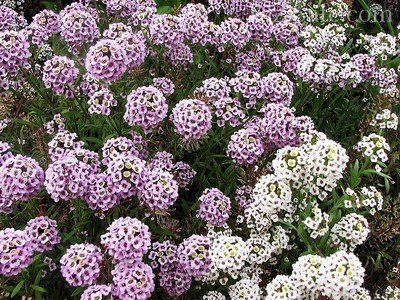

Alyssum is an annual low-growing plant with a pronounced aroma. The compact bushes grow to form a carpet. Suitable for framing flower beds and borders, and for filling rocky gardens
The flowers of alyssum marine are white or purple in color, which is used when planting plants together. After a cosmetic haircut and abundant watering, the alissum is ready for a new wave of flowering. Having planted this fragrant annual once, you do not have to worry about over-sowing seeds for two to three years. Alyssum reproduces well by self-seeding.
More information about the features of growing alyssum in the garden:

